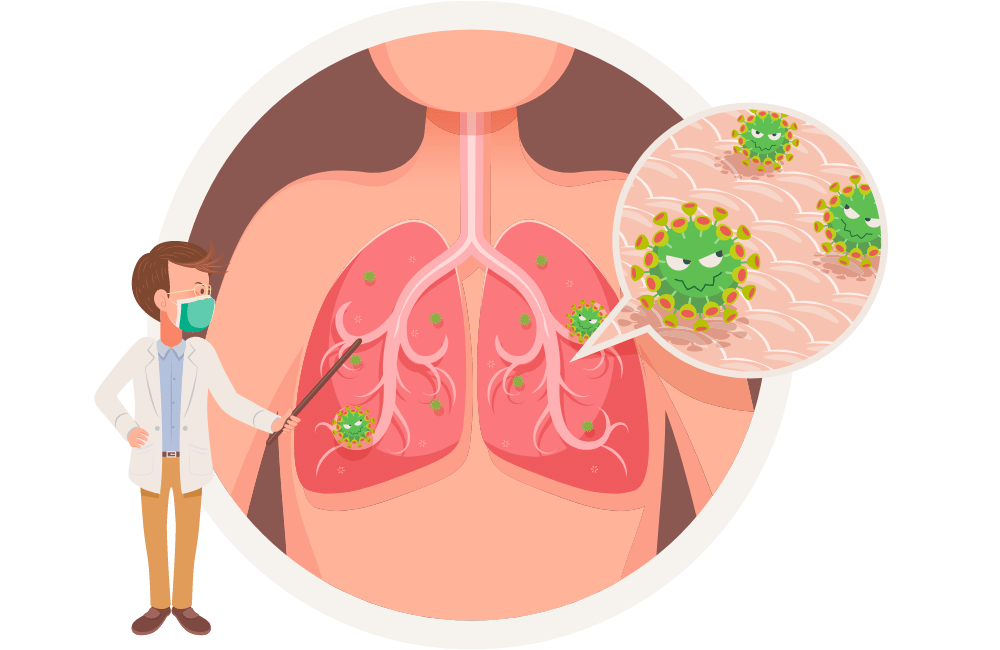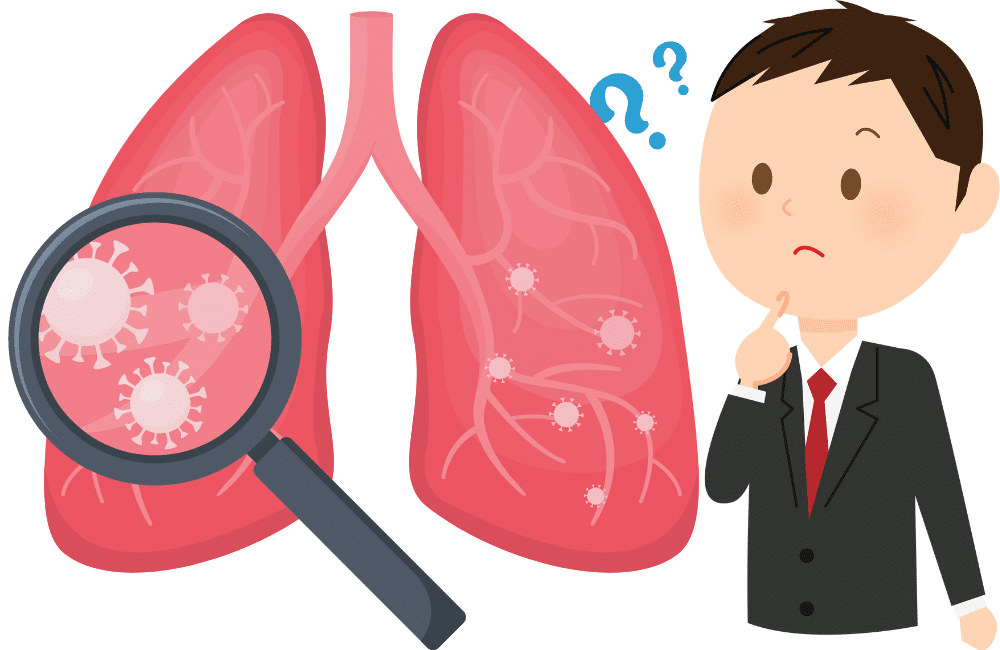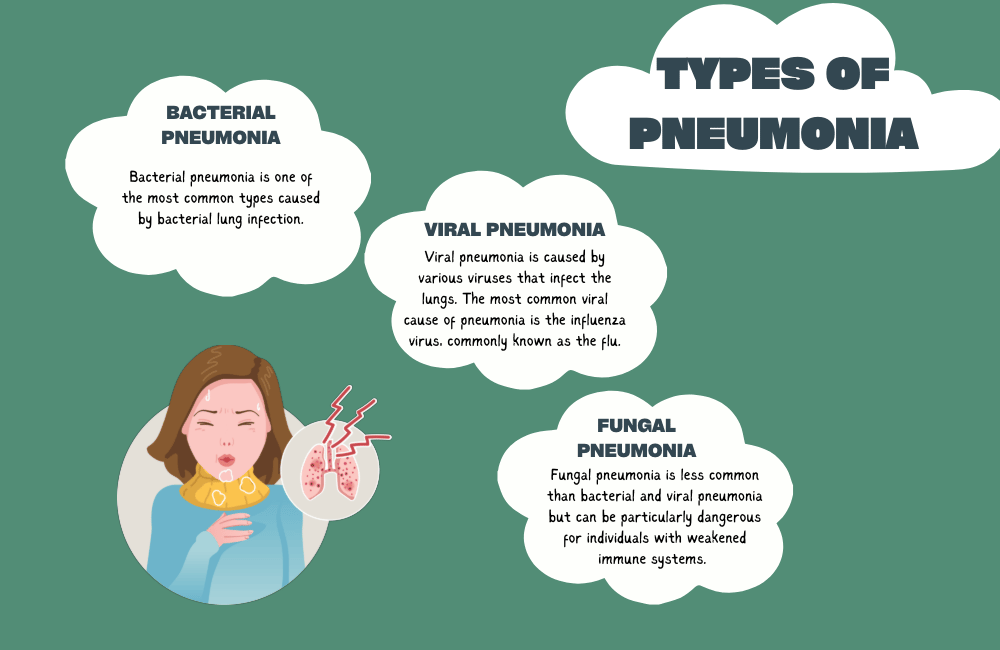Pneumonia is a serious and potentially life-threatening respiratory infection that affects the lungs. It can be caused by various pathogens, including bacteria, viruses, fungi, and even certain chemicals. Understanding its symptoms, risk factors, and appropriate treatment options is crucial for effective management.

Do you want to know what is pneumonia and how to treat it? Don’t worry we got you covered. Let’s get started. But if you want to get deep information about pneumonia, watch the video below.
What is Pneumonia?
Pneumonia is an infection that inflames the air sacs in one or both lungs, accumulating fluid or pus. This accumulation makes it difficult for the lungs to function correctly, causing symptoms such as cough, fever, difficulty breathing, and chest pain. The severity of pneumonia can range from mild to severe, and it can be particularly dangerous for infants, older adults, and people with weakened immune systems.

Types of Pneumonia
Pneumonia is a respiratory infection caused by various pathogens, each leading to different types of pneumonia. Understanding these different types is crucial for accurate diagnosis and effective treatment. Let’s explore each type of pneumonia in detail:

1. Bacterial Pneumonia:
Bacterial pneumonia is one of the most common types caused by bacterial lung infection. The primary bacteria responsible for bacterial pneumonia is Streptococcus pneumoniae, also known as pneumococcus. This bacterium can infect the upper respiratory tract and then travel to the lungs, leading to inflammation and infection.
Other bacteria that can cause bacterial pneumonia include Haemophilus influenza and Staphylococcus aureus. Haemophilus influenzae typically affects individuals with weakened immune systems, chronic lung diseases, or other underlying health conditions. Staphylococcus aureus can cause community-acquired and hospital-acquired pneumonia, and certain strains can be virulent and resistant to antibiotics.
Bacterial pneumonia can affect people of all ages but is more common in young children, older adults, and individuals with weakened immune systems.
2. Viral Pneumonia:
Viral pneumonia is caused by various viruses that infect the lungs. The most common viral cause of pneumonia is the influenza virus, commonly known as the flu. Influenza-related pneumonia can be severe, especially in vulnerable populations like young children, older adults, and individuals with underlying health conditions.
Respiratory syncytial virus (RSV) is another common cause of viral pneumonia, particularly in infants and young children. RSV infections can lead to severe respiratory symptoms and may sometimes require hospitalization.
The SARS-CoV-2 virus responsible for COVID-19 has recently emerged as a significant cause of viral pneumonia. COVID-19 pneumonia can range from mild to severe and may lead to acute respiratory distress syndrome (ARDS) in severe cases.
3. Fungal Pneumonia:
Fungal pneumonia is less common than bacterial and viral pneumonia but can be particularly dangerous for individuals with weakened immune systems. It is primarily caused by fungal species such as Pneumocystis jirovecii.
Pneumocystis pneumonia (PCP) is a fungal pneumonia that primarily affects people with compromised immune systems, such as those with HIV/AIDS or individuals undergoing immunosuppressive therapy. PCP can be severe and even life-threatening in these vulnerable populations.
Other fungal pathogens, such as Histoplasma capsulatum and Cryptococcus neoformans, can cause pneumonia in specific geographical regions or conditions.
Symptoms of Pneumonia
Pneumonia is a serious respiratory infection that can cause a range of symptoms. Recognizing these symptoms is essential for early detection and prompt medical attention. The severity and presentation of symptoms can vary depending on the type of pneumonia, the causative pathogen, and the individual’s overall health. Let’s explore the common and additional symptoms associated with pneumonia:
Common Symptoms
- Cough with Phlegm or Pus: One of the hallmark symptoms of pneumonia is a persistent cough that produces phlegm or pus. The cough may start drying but can become productive with yellow, green, or bloody mucus. The mucus or pus indicates an infection in the airways and lungs.
- Fever and Chills: Pneumonia often causes an elevated body temperature, leading to fever and chills. The body’s immune response to the infection increases body heat to fight off the invading pathogens.
- Shortness of Breath and Rapid Breathing: As the infection progresses, the air sacs in the lungs become inflamed and filled with fluid or pus. This can impair oxygen exchange and carbon dioxide, leading to shortness of breath and an increased respiratory rate.
- Chest Pain, especially when Breathing Deeply or Coughing: The inflammation of the lungs can cause chest pain, which may worsen with deep breaths or coughing. The pain is often described as sharp and may be localized or spread across the chest.
Additional Symptoms in Severe Cases
- Bluish or Grayish Skin due to Lack of Oxygen: In severe cases of pneumonia, especially when oxygen levels in the blood are significantly reduced, the skin and lips may appear bluish or grayish, a condition called cyanosis. This indicates inadequate oxygenation of tissues.
- Confusion, particularly in Older Adults: Pneumonia can affect brain function, leading to confusion, disorientation, or altered mental status. This is more common in older adults and those with weakened immune systems.
- Nausea, Vomiting, or Diarrhea: Some individuals with pneumonia, especially children, may experience gastrointestinal symptoms like nausea, vomiting, or diarrhea. These symptoms can be more pronounced in viral or atypical forms of pneumonia.
It is important to note that some people, especially older adults and those with underlying health conditions, may have atypical or milder symptoms. For instance, they may present with confusion or delirium without exhibiting classic respiratory symptoms. Therefore, a healthcare professional should promptly evaluate any unexplained change in an individual’s health status.
If you or someone you know is experiencing any of the symptoms mentioned above, especially in combination, seeking immediate medical attention is crucial. Early diagnosis and appropriate treatment can significantly improve outcomes and reduce the risk of severe pneumonia-related complications.
Risk Factors for Pneumonia
Pneumonia is a respiratory infection that can affect individuals of all ages, but certain risk factors can increase an individual’s susceptibility to developing the disease. Understanding these risk factors is crucial for both prevention and early detection of pneumonia. Let’s delve into each risk factor in detail:
1. Age
Age plays a significant role in the vulnerability to pneumonia. Children under the age of 2 years and adults over the age of 65 are at a higher risk of developing pneumonia. The immune system is still developing in young children, making them more susceptible to infections. Additionally, children in this age group often have closer contact with other children, increasing the likelihood of exposure to infectious agents.
The immune system may weaken in older adults, making it less efficient at combating infections. Moreover, older adults often have one or more chronic health conditions, further compromising their ability to fight respiratory infections like pneumonia. As a result, pneumonia can be more severe and lead to complications in these age groups.
2. Weakened Immune System
Individuals with a weakened immune system are at a higher risk of developing pneumonia. Conditions that suppress the immune system, such as HIV/AIDS or cancer, can impair the body’s ability to fight infections effectively. As a result, these individuals may be more susceptible to contracting pneumonia from various pathogens, including bacteria, viruses, and fungi.
Moreover, people undergoing chemotherapy or other immunosuppressive treatments are also at an increased risk. These treatments are essential for managing certain medical conditions but can also weaken the immune system, making the individual more susceptible to infections like pneumonia.
3. Chronic Conditions
Chronic lung diseases, such as asthma and chronic obstructive pulmonary disease (COPD), can increase an individual’s vulnerability to pneumonia. These conditions can cause damage to the lung tissues and impair the lung’s natural defense mechanisms, making it easier for infectious agents to invade and cause infection.
Heart disease, especially congestive heart failure, is another chronic condition that can elevate the risk of pneumonia. The fluid buildup in the lungs associated with heart failure creates an environment conducive to the growth of bacteria, making the lungs more susceptible to infection.
Diabetes, particularly poorly controlled, can also increase the risk of pneumonia. High blood sugar levels can weaken the immune system, making it more difficult to combat infections effectively.
4. Smoking
Smoking is a significant risk factor for pneumonia. Cigarette smoke damages the respiratory tract’s lining, impairs the clearance of mucus and debris from the airways, and weakens the immune system. Smokers are more likely to have chronic respiratory conditions, making them more susceptible to pneumonia caused by both bacteria and viruses.
Additionally, smoking can cause a reduction in ciliary function—hair-like structures that help clear pathogens and debris from the airways—which further increases the risk of lung infections like pneumonia.
Here is a guide for you to limit your smoking and alcohol habits.
Diagnosing Pneumonia
Prompt and accurate diagnosis of pneumonia is crucial for timely and effective treatment. Healthcare professionals use a combination of methods to diagnose pneumonia, considering the patient’s symptoms, medical history, and physical examination findings. Let’s explore each diagnostic method in detail:
1. Physical Examination:
The first step in diagnosing pneumonia is a thorough physical examination. The healthcare provider will listen to the patient’s chest using a stethoscope. Abnormal lung sounds, such as crackles or wheezing, may indicate the presence of fluid or inflammation in the lungs. The examination may also include assessing the patient’s vital signs, such as heart rate, respiratory rate, and temperature, to check for signs of infection.
2. Chest X-ray:
A chest X-ray is one of the most common imaging tests to diagnose pneumonia. It provides detailed images of the lungs, allowing healthcare professionals to identify areas of inflammation, fluid, or consolidation that may indicate an infection. A chest X-ray can help differentiate between bacterial, viral, and fungal pneumonia based on the pattern of lung involvement.
In bacterial pneumonia, a localized consolidation of lung tissue may be observed. In viral pneumonia, the X-ray may show a more diffuse pattern of lung involvement. Fungal pneumonia may present with unique patterns depending on the specific pathogen.
3. Blood Tests:
Blood tests can be helpful in diagnosing pneumonia and determining the causative agent. A complete blood count (CBC) can reveal an elevated white blood cell count, which indicates an ongoing infection. A high level of C-reactive protein (CRP) and erythrocyte sedimentation rate (ESR) can also suggest an inflammatory response.
Blood cultures may be performed to identify the specific bacterium causing bacterial pneumonia. For viral pneumonia, serology tests can detect antibodies specific to the virus. Elevated levels of specific antibodies can indicate a recent or current viral infection.
4. Sputum Culture:
A sputum culture involves collecting a sample of phlegm or mucus that the patient coughs up from their lungs. This sample is then sent to the laboratory for analysis to identify the causative agent of the infection. A sputum culture can help differentiate between bacterial, viral, and fungal pneumonia.
In bacterial pneumonia, the laboratory can culture the bacteria from the sputum and perform sensitivity testing to determine the most effective antibiotic for treatment. Specific viral antigens or genetic material can be detected in viral pneumonia through molecular testing.
It is essential to collect a high-quality sputum sample to ensure accurate results. If a patient has difficulty producing sputum, the healthcare provider may use techniques like a deep cough or sputum induction to obtain the necessary sample.
Treating Pneumonia
The treatment for pneumonia varies based on the type of pneumonia (bacterial, viral, or fungal) and the severity of the infection. Prompt and appropriate treatment is essential to control the infection, relieve symptoms, and prevent complications. Let’s explore the various treatment approaches for different types of pneumonia:
1. Antibiotics for Bacterial Pneumonia:
Bacterial pneumonia is most commonly treated with antibiotics. The choice of antibiotics depends on the specific bacterium causing the infection and its sensitivity to different drugs. Healthcare professionals typically prescribe broad-spectrum antibiotics initially, which can target a wide range of bacteria.
Commonly prescribed antibiotics for bacterial pneumonia include:
- Penicillin or Amoxicillin
- Macrolides (such as Azithromycin or Clarithromycin)
- Fluoroquinolones (such as Levofloxacin or Moxifloxacin)
For severe cases or individuals with risk factors for antibiotic-resistant bacteria, stronger or intravenous (IV) antibiotics may be required. It is essential to complete the full course of antibiotics as prescribed by the healthcare provider, even if symptoms improve, to ensure complete eradication of the infection.
2. Antiviral Medications for Viral Pneumonia:
Viral pneumonia caused by specific viruses like influenza requires antiviral medications. These medications target the virus directly, inhibiting its replication and reducing the severity and duration of the infection.
For influenza (flu) pneumonia, antiviral drugs such as oseltamivir (Tamiflu), zanamivir (Relenza), or peramivir (Rapivab) are commonly used. Early initiation of antiviral treatment is critical for its effectiveness, so it is essential to seek medical attention as soon as symptoms suggestive of influenza develop.
Depending on the virus and its sensitivity to medications, specific antiviral treatments may be available for viral pneumonia caused by other viruses.
3. Antifungal Drugs for Fungal Pneumonia:
Fungal pneumonia is treated with antifungal medications. The choice of antifungal drug depends on the specific fungal pathogen causing the infection. For common fungal pneumonia caused by Pneumocystis jirovecii, medications like trimethoprim-sulfamethoxazole (TMP-SMX) are commonly used.
Antifungal drugs such as fluconazole, itraconazole, or voriconazole may be prescribed for other types of fungal pneumonia. The treatment duration and choice of drug will depend on the severity of the infection and the individual’s overall health.
4. Supportive Care:
Regardless of the type of pneumonia, supportive care is essential to help manage symptoms and promote recovery. Supportive care measures include:
- Rest: Resting allows the body to focus on fighting the infection and healing the lungs.
- Hydration: Staying well-hydrated helps loosen mucus and makes it easier to cough up.
- Fever-Reducing Medications: Over-the-counter medications like acetaminophen or ibuprofen can help reduce fever and alleviate discomfort.
- Oxygen Therapy: For severe cases or individuals with low oxygen levels, supplemental oxygen may be provided to maintain adequate oxygenation.
- Respiratory Therapy: Breathing exercises, incentive spirometry, or chest physiotherapy can help improve lung function and clear mucus.
Individuals with pneumonia must follow their healthcare provider’s advice, take prescribed medications as directed, and attend follow-up appointments as needed to ensure proper recovery.
Final Thoughts
Pneumonia is a potentially serious infection that affects the lungs and can lead to severe complications if left untreated. Understanding the symptoms, risk factors, and available treatment options is crucial for timely intervention and successful recovery. If you suspect you or a loved one may have pneumonia, seek medical attention promptly to receive the appropriate care and treatment.
Remember to follow preventive measures, such as maintaining good hygiene, getting vaccinated, and avoiding exposure to respiratory pathogens, to reduce the risk of contracting pneumonia. Stay informed and prioritize your respiratory health for a better quality of life.

